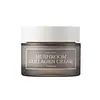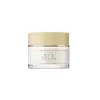What's inside
What's inside
 Key Ingredients
Key Ingredients

 Benefits
Benefits

 Concerns
Concerns

 Ingredients Side-by-side
Ingredients Side-by-side

Water
Skin ConditioningTremella Fuciformis Extract 30%
HumectantGlycerin
HumectantHydrogenated Poly(C6-14 Olefin)
EmollientPentaerythrityl Tetraethylhexanoate
EmollientCaprylic/Capric Triglyceride
MaskingPolyglyceryl-3 Methylglucose Distearate
EmulsifyingNiacinamide
SmoothingVinyldimethicone
Diisostearyl Malate
EmollientMethyl Trimethicone
Skin ConditioningCetearyl Alcohol
EmollientBehenyl Alcohol
EmollientCetearyl Olivate
Sorbitan Olivate
EmulsifyingPhytosteryl/Isostearyl/Cetyl/Stearyl/Behenyl Dimer Dilinoleate
Skin ConditioningDioscorea Japonica Root Extract
Skin ConditioningSoluble Collagen
HumectantHydroxyethyl Acrylate/Sodium Acryloyldimethyl Taurate Copolymer
Emulsion StabilisingSodium Stearoyl Glutamate
CleansingAmmonium Acryloyldimethyltaurate/Vp Copolymer
Butylene Glycol
HumectantXanthan Gum
EmulsifyingAdenosine
Skin ConditioningSorbitan Isostearate
EmulsifyingHydrolyzed Corn Starch
HumectantBeta-Glucan
Skin ConditioningSucrose
HumectantCeramide NP
Skin ConditioningMannose
HumectantGlucose
Humectant1,2-Hexanediol
Skin ConditioningHydroxyacetophenone
AntioxidantEthylhexylglycerin
Skin ConditioningWater, Tremella Fuciformis Extract 30%, Glycerin, Hydrogenated Poly(C6-14 Olefin), Pentaerythrityl Tetraethylhexanoate, Caprylic/Capric Triglyceride, Polyglyceryl-3 Methylglucose Distearate, Niacinamide, Vinyldimethicone, Diisostearyl Malate, Methyl Trimethicone, Cetearyl Alcohol, Behenyl Alcohol, Cetearyl Olivate, Sorbitan Olivate, Phytosteryl/Isostearyl/Cetyl/Stearyl/Behenyl Dimer Dilinoleate, Dioscorea Japonica Root Extract, Soluble Collagen, Hydroxyethyl Acrylate/Sodium Acryloyldimethyl Taurate Copolymer, Sodium Stearoyl Glutamate, Ammonium Acryloyldimethyltaurate/Vp Copolymer, Butylene Glycol, Xanthan Gum, Adenosine, Sorbitan Isostearate, Hydrolyzed Corn Starch, Beta-Glucan, Sucrose, Ceramide NP, Mannose, Glucose, 1,2-Hexanediol, Hydroxyacetophenone, Ethylhexylglycerin
Oryza Sativa Bran Water
MaskingWater
Skin ConditioningGlycerin
HumectantButylene Glycol
HumectantCetyl Ethylhexanoate
EmollientPentaerythrityl Tetraethylhexanoate
EmollientHydrogenated Polyisobutene
EmollientSynthetic Beeswax
Emulsion StabilisingButyrospermum Parkii Butter
Skin ConditioningPolyglyceryl-3 Methylglucose Distearate
EmulsifyingVinyldimethicone
Pentylene Glycol
Skin Conditioning1,2-Hexanediol
Skin ConditioningBehenyl Alcohol
EmollientGlyceryl Stearate
EmollientAmmonium Acryloyldimethyltaurate/Vp Copolymer
Bisabolol
MaskingCetearyl Olivate
Panthenol
Skin ConditioningSorbitan Olivate
EmulsifyingCaprylyl Glycol
EmollientEthylhexylglycerin
Skin ConditioningXanthan Gum
EmulsifyingAdenosine
Skin ConditioningTrisodium Ethylenediamine Disuccinate
Sodium Hyaluronate
HumectantCeramide NP
Skin ConditioningHydrolyzed Hyaluronic Acid
HumectantOryza Sativa Bran Oil
EmollientTocopherol
AntioxidantPhytosphingosine
Skin ConditioningCaprylic/Capric Triglyceride
MaskingHydrogenated Lecithin
EmulsifyingOryza Sativa Bran Water, Water, Glycerin, Butylene Glycol, Cetyl Ethylhexanoate, Pentaerythrityl Tetraethylhexanoate, Hydrogenated Polyisobutene, Synthetic Beeswax, Butyrospermum Parkii Butter, Polyglyceryl-3 Methylglucose Distearate, Vinyldimethicone, Pentylene Glycol, 1,2-Hexanediol, Behenyl Alcohol, Glyceryl Stearate, Ammonium Acryloyldimethyltaurate/Vp Copolymer, Bisabolol, Cetearyl Olivate, Panthenol, Sorbitan Olivate, Caprylyl Glycol, Ethylhexylglycerin, Xanthan Gum, Adenosine, Trisodium Ethylenediamine Disuccinate, Sodium Hyaluronate, Ceramide NP, Hydrolyzed Hyaluronic Acid, Oryza Sativa Bran Oil, Tocopherol, Phytosphingosine, Caprylic/Capric Triglyceride, Hydrogenated Lecithin
 Reviews
Reviews

Ingredients Explained
These ingredients are found in both products.
Ingredients higher up in an ingredient list are typically present in a larger amount.
1,2-Hexanediol is a synthetic liquid and another multi-functional powerhouse.
It is a:
- Humectant, drawing moisture into the skin
- Emollient, helping to soften skin
- Solvent, dispersing and stabilizing formulas
- Preservative booster, enhancing the antimicrobial activity of other preservatives
Adenosine is in every living organism. It is one of four components in nucleic acids that helps store our DNA.
Adenosine has many benefits when used. These benefits include hydrating the skin, smoothing skin, and reducing wrinkles. Once applied, adenosine increases collagen production. It also helps with improving firmness and tissue repair.
Studies have found adenosine may also help with wound healing.
In skincare products, Adenosine is usually derived from yeast.
Learn more about AdenosineAmmonium Acryloyldimethyltaurate/Vp Copolymer (let's call it AAVC for short) is a synthetically created polymer. It's used as a film-forming agent and used to thicken the consistency of products.
AAVC is able to increase the consistency and viscosity of products due to its large molecule size. It also prevents ingredients from separating.
Behenyl Alcohol is a type of fatty alcohol (these are different from the drying, solvent alcohols).
Fatty Alcohols have hydrating properties and are most often used as an emollient or to thicken a product. They are usually derived from natural fats and oils; behenyl alcohol is derived from the fats of vegetable oils.
Emollients help keep your skin soft and hydrated by creating a film that traps moisture in.
In 2000, Behenyl Alcohol was approved by the US as medicine to reduce the duration of cold sores.
Learn more about Behenyl AlcoholButylene Glycol (or BG) is used within cosmetic products for a few different reasons:
Overall, Butylene Glycol is a safe and well-rounded ingredient that works well with other ingredients.
Though this ingredient works well with most skin types, some people with sensitive skin may experience a reaction such as allergic rashes, closed comedones, or itchiness.
Learn more about Butylene GlycolThis ingredient is an emollient, solvent, and texture enhancer. It is considered a skin-softener by helping the skin prevent moisture loss.
It helps thicken a product's formula and makes it easier to spread by dissolving clumping compounds.
Caprylic Triglyceride is made by combining glycerin with coconut oil, forming a clear liquid.
While there is an assumption Caprylic Triglyceride can clog pores due to it being derived from coconut oil, there is no research supporting this.
Learn more about Caprylic/Capric TriglycerideCeramide NP is a type of ceramide.
Ceramides are intercellular lipids naturally found in our skin that bonds dead skin cells together to create a barrier. They are known for their ability to hold water and thus are a great ingredient for dry skin.
Ceramides are an important building block for our skin barrier. A stronger barrier helps the skin look more firm and hydrated. By bolstering the skin ceramides act as a barrier against irritating ingredients. This can help with inflammation as well.
If you would like to eat ceramides, sweet potatoes contain a small amount.
Read more about other common types of ceramides here:
Ceramide AP
Ceramide EOP
Cetearyl Olivate is an emulsifier and texture enhancer. It is derived from the fatty acids of olive oil and Cetearyl alcohol, and is biodegradable.
As an emulsifier, it is used to prevent oils and waters from separating. It can also
Manufacturers use the name Olivem 1000. This ingredient has been found to preserve the natural microbiome of skin. Having a healthy microbiome helps keep our skin healthy and protects against harmful bacteria. This ingredient is grouped with Sorbitan Olivate under the name Olivem 1000.
Learn more about Cetearyl OlivateEthylhexylglycerin (we can't pronounce this either) is commonly used as a preservative and skin softener. It is derived from glyceryl.
You might see Ethylhexylglycerin often paired with other preservatives such as phenoxyethanol. Ethylhexylglycerin has been found to increase the effectiveness of these other preservatives.
Glycerin is already naturally found in your skin. It helps moisturize and protect your skin.
A study from 2016 found glycerin to be more effective as a humectant than AHAs and hyaluronic acid.
As a humectant, it helps the skin stay hydrated by pulling moisture to your skin. The low molecular weight of glycerin allows it to pull moisture into the deeper layers of your skin.
Hydrated skin improves your skin barrier; Your skin barrier helps protect against irritants and bacteria.
Glycerin has also been found to have antimicrobial and antiviral properties. Due to these properties, glycerin is often used in wound and burn treatments.
In cosmetics, glycerin is usually derived from plants such as soybean or palm. However, it can also be sourced from animals, such as tallow or animal fat.
This ingredient is organic, colorless, odorless, and non-toxic.
Glycerin is the name for this ingredient in American English. British English uses Glycerol/Glycerine.
Learn more about GlycerinPentaerythrityl Tetraethylhexanoate is an emollient that helps make your skin smooth and hydrated. It specializes in creating a non-oily and "wet" feeling on skin.
This ingredient comes from isostearic acid, a saturated fatty acid. It is a synthetic ingredient.
Polyglyceryl-3 Methylglucose Distearate is created from the diester of stearic acid and the condensation product of methylglucose and Polyglycerin-3.
As an emulsifier, it is used to bind ingredients together. Many ingredients, such as oils and water, separate naturally. Emulsifiers prevent them from separating to ensure even consistency in texture.
One of the manufacturer for this ingredient states it is vegetable-based. It is also claimed to be stable at both high and low temperatures.
This ingredient may not be safe for fungal acne. We recommend speaking with a professional if you have any concerns.
Learn more about Polyglyceryl-3 Methylglucose DistearateSorbitan Olivate is created from the fatty acids in olive oil and sorbitol.
This ingredient is an oil in water emulsifier. It helps stabilize a product by preventing oils and waters from separating. Sorbitan Olivate also helps hydrate the skin.
Manufacturers sell sorbitan olivate under the name OliveM 1000. OliveM 1000 a multifunctional ingredient. It is self-emulsifying. According to a manufacturer, OliveM 1000 does not disrupt natural skin biome.
Due to its olive oil base, this ingredient may not be fungal-acne safe.
Learn more about Sorbitan OlivateVinyldimethicone is a type of silicone.
Water. It's the most common cosmetic ingredient of all. You'll usually see it at the top of ingredient lists, meaning that it makes up the largest part of the product.
So why is it so popular? Water most often acts as a solvent - this means that it helps dissolve other ingredients into the formulation.
You'll also recognize water as that liquid we all need to stay alive. If you see this, drink a glass of water. Stay hydrated!
Learn more about WaterXanthan gum is used as a stabilizer and thickener within cosmetic products. It helps give products a sticky, thick feeling - preventing them from being too runny.
On the technical side of things, xanthan gum is a polysaccharide - a combination consisting of multiple sugar molecules bonded together.
Xanthan gum is a pretty common and great ingredient. It is a natural, non-toxic, non-irritating ingredient that is also commonly used in food products.
Learn more about Xanthan Gum